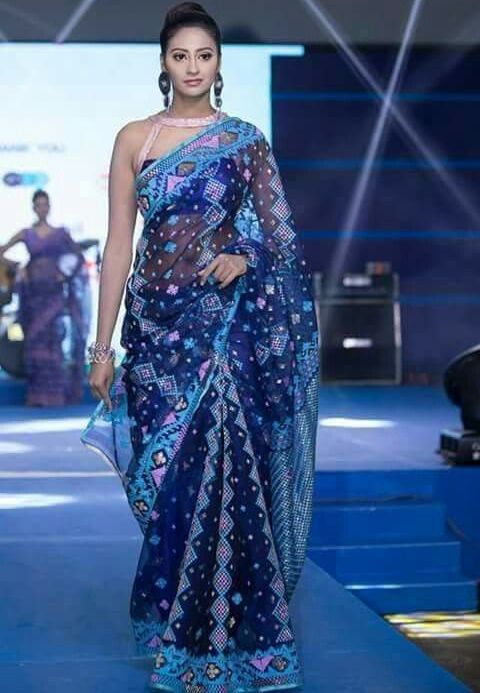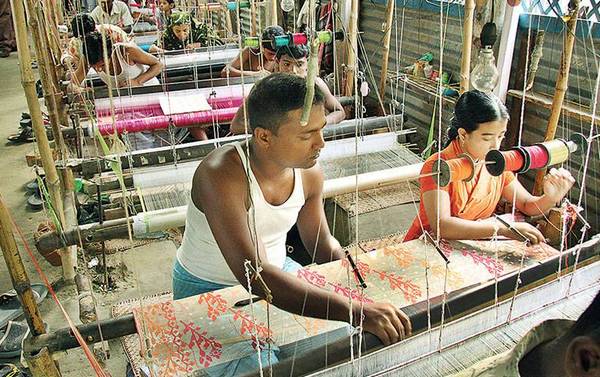Introduction:
Jamdani saree is very well known to Bengali women as the inheritor of ancient fine muslin cloth. Jamdani cloth is made by designing on muslin. Although fine, fine and smooth muslin is now extinct due to various reasons in the course of time, a branch of muslin known as jamdani still survives.
There are different views on the naming of Jamdani. The word ‘jamdani’ comes from the Persian language. Persian ‘jam’ means cloth and ‘dana’ means buti. In that sense, Jamdani means embroidered cloth. The introduction of jamdani and muslin started around the same time. The earliest mention of Jamdani is found in Kautilya’s Arthashastra. In the descriptions of various Arab, Chinese and Italian tourists and traders. Kautilya’s book mentions the finest textiles in Bengal and Pundra areas. Among them were Khusum, Dukul, Patron and Karpasika. At the time of export, the name of Kapasikar is muslin. Muslin was one colour. And the cloth embroidered in it was called Jamdani. Originally, muslin flourished in Dhaka district. Senargaon, Dhamrai and Rupganj in Dhaka were famous for muslin. During the Maghal period, Jamdani spread widely. Emperor Jahangir protected Jamdani. The eminent traveler Ibn Battuta, in his travelogue written in the fourteenth century, praised the textile industry of Sainargaon and spoke of muslin and jamdani. However, all the famous and unforgettable designs and weaves of Jamdani sarees are now almost extinct. Now the industry resides in about 155 villages of Rupganj, Sonargaon and Siddhirganj.
Jamdani is a wearable garment made of cotton with a unique weaving method. Jamdani usually means saree. However, nakshiorna, kurta, turban, handkerchief, curtain etc. were also made with jamdani. Sherwani designs with jamdani were in vogue in the 1800s. Jamdani cloth was also used to dye the regional clothing of the Mughals and Nepal. The design is embroidered with a third yarn while weaving the jamdani. As a minimum of 300 count of yarn is used in muslin weaving, 70-80 counts of yarn are usually used in weaving jamdani. Hale Jamdani is made in many places but Dhaka is considered to be the original birthplace of Jamdani. The unique method of weaving jamdani has been recognized by UNESCO as a unique intangible cultural heritage.
Jamdani saree is very difficult and time consuming as weavers weave it by hand. So the price of these is also higher than other sarees. If two artisans work 12 to 14 hours a day to make a Jamdani saree, then it can take seven days to six months to make a complete sari depending on the design. Usually when making a sari, the price of a jamdani can range from taka 3,000 to taka 120,000 or more, depending on the quality of the yarn and the fineness of the work. Since Jamdani saree is hand-woven, the design of the saree is very delicate and perfect. The designs are smooth. The artisan weaves each yarn by hand. No part of the yarn comes out. For this reason, it is very difficult to differentiate between the front part of the Jamdani sari and the inner part.

There are several types of Jamdani Saree. Such as cotton jamdani, half silk jamdani, silk jamdani. The whole hand-knitted jamdani is actually the real jamdani. Handloom jamdani is as comfortable to wear as it is to last for many years. On the other hand, the power loom jamdani which is not a jamdani at all. It is being sold at a low price by imitating the design of Jamdani and weaving polyester yarn. This polyester jamdani is uncomfortable if it is worn for a long time. In addition, there may be various skin problems. In the machine, the exact design is imitated only in imitation of Jamdani saree. The reverse back of these saris is cut in the threads. Another way to recognize Jamdani sari is to check its yarn and smoothness. Cotton and silk yarn are used in weaving Jamdani saree.

There are three common types of jamdani in terms of yarn use:
- Flower Cotton Jamdani – which is made with cotton yarn.
- Half-Silk Jamdani – where horizontal yarns are made of silk and vertical yarns are made of cotton.
- Flower-Silk Jamdani – where the two ends are made of silk.
Features of Jamdani:
The main feature of Jamdani is its geometric design. In this geometric design, various designs including flowers, herbs, kalka are boiled. There are different types of jamdani designs. Among them Panna Hazar, Tercha, Pansi, Mayurpankhi, Batpata, Karla, Jal, Butidar, Jalpar, Dubli, Duria, Balihar, Katihar, Kalkapar etc. are more prevalent. If the design of six flowers or herbs in a jamdani is aligned obliquely, then it is called oblique jamdani. According to the weaving of flowers and vines in all the ground, it is called the design of the net. Phulkata Jamdani Phulwar, lined up all over the ground. The duria jamdani is decorated in derakata designs. Similarly, if there is a design of Kalki on the bank, it will be kalkapar.
Jamdani artisans situation are not good. Despite being recognized as a Geographical Indication (GI) product in Bangladesh, the plight of the artisans associated with the industry has not abated. Jamdani is the pride of this country in beauty, design, weaving and tradition. Though Jamdani is on the UNESCO Intangible Cultural Heritage list. But the branding of Jamdani did not take the initiative that should have been taken by the government and the private sector. Entrepreneurs in this industry do not have the benefit of short-term long-term bank loans. Weavers are leaning because they do not get a fair price. So they move in other professions. But as a result of artwork and decorative design. As a symbol of nobility, the Jamdani saree is still appreciated in the country as well as around the world. And by capitalizing on this, the market is full of fake jamdani. Buyers are being deceived by buying fake jamdani due to low prices.
If people want to improve the Jamdani industry in any corner, they have to market it, they have to introduce it to the big world. And for this, the government grant policy has to be implemented properly and the artisans also have to make some changes in the method of making garments. For example, artisans don’t have to think only about making sari, you have to think about making orna, kameez and many other practical closures. For this reason, more importance should be given to the preparation of cotton jamdani. With the help of cotton jamdani saree, various types of basic clothes, sheets, home decoration items etc. can be prepared to reduce the pain. These products are exported abroad in a lot of foreign currency.
References:
- https://en.m.wikipedia.org/wiki/Jamdani
- https://www.craftsvilla.com/blog/traditional-art-of-weaving-jamdani-saree/
- https://sites.google.com/site/mgbdtraditional/apple-free
- https://www.thedailystar.net/star-weekend/spotlight/news/jamdani-fabric-then-and-now-1814971
- http://en.banglapedia.org/index.php/Jamdani
- https://artsandculture.google.com/exhibit/jamdani-the-art-of-weaving-ichcap/
- https://www.vogue.in/content/jamdani-saree-history-origin-technique-indian-handloom
Author of this Article:
Nazifa Tabassum
B.Sc. in Clothing and Textile
College of Home Economics, Dhaka
Email: nazifa.099@gmail.com
You may also like:

Hi Nazifa Tabassum,
This is Rayhan Sheikh. I was reading blogs about Jamdani saree. Then I got your blog and it was amazing. Specially “the three common types of jamdani in terms of yarn” information was new for me.
Thank you for your information.